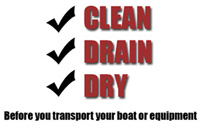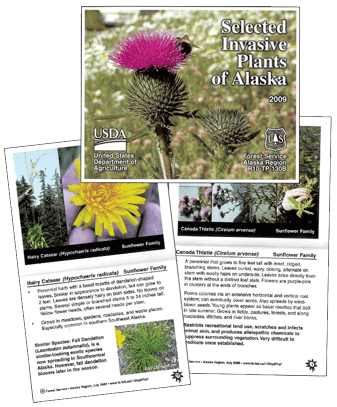Invasive Plants and Agricultural Pest Management
Welcome to Alaska's Invasive Plant Program. Our program coordinates prevention, outreach and management strategies for invasive plant issues through collaboration with land managers, agencies, organizations and policy makers across Alaska. These efforts are guided by the implementation of our Strategic Plan and relevant noxious weed regulations and policies. Our goal is to help keep Alaska's pristine landscapes and natural resources free from impacts of noxious and invasive plants.
PMC Programs
- PMC Home Page
- Horticulture
- Industrial Hemp
- Invasive Plants
- Plant Pathology

5310 S Bodenburg Spur
Palmer, AK 99645
Phone: 907-745-4469
Fax: 907-746-1568
Mon. - Fri.
8 a.m. - 4 p.m.
Click Map For Directions
View Larger Map
Current Projects
Exterior Quarantine of Aquatic Invasive Weeds
What Are They?
Invasive species can be species of animals, plants, microorganisms, or pathogens that take over the habitat of other species, forcing the native species to decline in population or to disappear from their natural environment. They are highly competitive, highly adaptive, and successful at reproducing in many environments, including Alaska.

Why Should You Care?
Alaska is called "The Last Frontier" because of its vast natural areas including national and state parks, national forests, conservation areas, and its scenic and majestic rivers and streams... all of which attract a great deal of both residents and non-residents to explore these areas. These natural areas possess a great deal of beauty and biological diversity; both important sources of economic strength for our state.
However, Alaska's resources are being threatened by invasive species. As travel and trade increase, the risk of new invasions also increases. Invasive species have a high price once they become established.
Invasive Species:
| • | Cost Americans more than $137 billion a year |
| • | Cost Alaskan agencies, non-profits, and private donors $29 million from 2007 to 2011 to manage invasive species: ISER |
| • | Can devastate industries including fisheries, agriculture, hydro-electric and recreation |
| • | Impede recreation such as boating, fishing, hunting, gardening and hiking |
| • | Spread easily by people, wind, water, animals, equipment and imported goods |
| • | Destabilizes soil and alters hydrology of streams, rivers, lakes and wetlands |
How Do They Get To Alaska?
Alaska is home to people who love traveling, the outdoors, hunting, fishing, berry-picking and gardening. When we travel to our favorite spots, our means of transportation become pathways for invasive species.
For example, ATVs can carry seeds from invasive plants in the mud on its tires. If the ATV is not properly cleaned before the next trip, it can drop these invasive seeds in a new, natural area that was previously free of invasive plants. People carry seeds on their clothing, on their shoes, and sometimes on their waders. Soils that have invasive plants can be dumped as fill in natural areas. Soil brought in with nursery stock may also have unwanted invasive seeds. Aquatic invasive species can get caught in plane rudders and boat motors.
There are many pathways for invasive species; some more important than others:
| • | Importation of seeds, fruits and vegetables |
| • | Ballast water discharged from ships |
| • | Boat motors and plane rudders |
What Can You Do?
Report any invasive species you find. Educate yourself about invasive species in Alaska and in your specific area. Request by email a USDA and US Forest Service Selected Invasive Plants of Alaska Pocket Guide (shown below) or the Alaska Plant Materials Center's Terrestrial Weed Identification Field Guide.

Prevention is the best way to stop invasive plants from taking over our natural lands. Here are a few things you can do to help keep Alaska pristine, beautiful, and majestic:
| • | Know where infestations of invasive plants are in your area: AKEPIC |
| • | Avoid planting invasive plants in your garden, or replace them with non-invasive alternatives |
| • | Inspect your boat and plane before traveling to other water bodies |
| • | Clean, Drain, and Dry all gear and equipment before using it in another waterbody |
| • | Never dispose of aquarium plants into waterbodies |
| • | Clean your ATVs, bikes and other gear before exploring a new area |
| • | GET INVOLVED! Ask your local CWMA or Soil and Water Conservation District how you can volunteer! |


